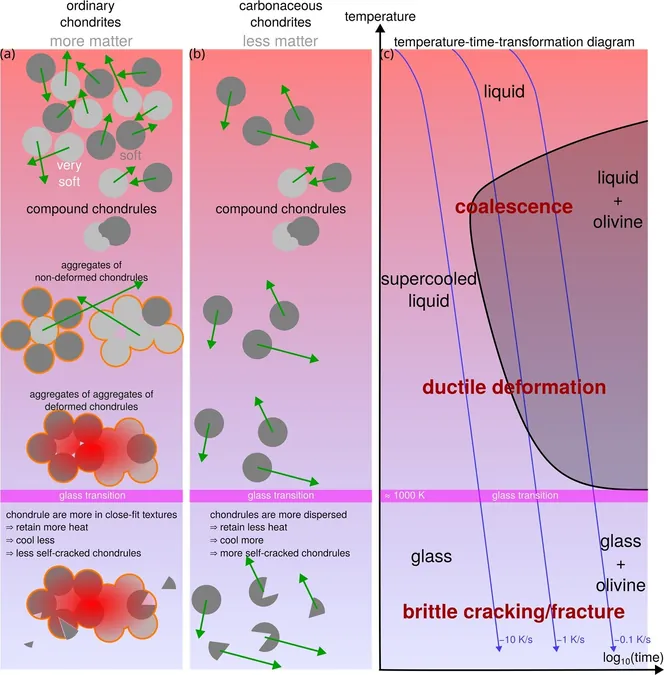
Revolutionary Findings Rewrite the History of Primitive Meteorite Formation!
2024-12-12
Author: Nur
Introduction to Chondritic Meteorites
Chondritic meteorites, known as chondrites, are among the oldest celestial rocks in our solar system, dating back around 4.5 billion years. Their ancient composition provides invaluable insights into the origins of planet formation, reflecting the fundamental elements of the sun's photosphere, including oxygen, silicon, magnesium, iron, and nickel.
Formation Process of Chondrites
Chondrites formed through the melting and accumulation (or accretion) of dust particles in the protoplanetary disk at astonishingly high temperatures, reaching up to 2,000 Kelvin (around 1,727 °C). This process produced chondrules—tiny, spherical aggregates of crystallized silicate—that ultimately clumped together to form asteroids, the building blocks of planets.
Types of Chondrites
There are two primary varieties of chondrites based on their formation location in the solar system: ordinary chondrites, which consist of up to 90% chondrules, and carbonaceous chondrites, containing only 20–50% chondrules surrounded by a complex matrix.
New Research Insights
Previously, scientists believed the chaotic environment of the early solar system, filled with high-energy collisions among space debris, was essential for deforming and fragmenting chondrules into the chondrites we observe today. However, groundbreaking research from Professor Guy Libourel and Dr. Anthony Seret at France's Laboratoire Lagrange at Université Côte d'Azur presents a different narrative.
Their study, published in Earth and Planetary Science Letters, suggests that chondrules can undergo both plastic deformation and fragmentation even at low collision velocities. Dr. Seret explains the significance of this revelation: "While past research primarily focused on chemical analysis, our approach emphasizes the mechanical properties of these objects, offering innovative perspectives on meteorite formation."
Research Methods and Findings
Through a series of sophisticated simulations, the researchers examined how chondrules behave across different temperature ranges. Remarkably, chondrules exhibit brittle behavior below a specific temperature threshold, whereas they flow like a viscous liquid above this threshold, facilitating ductile deformation.
A pivotal discovery from their research indicates that chondrule aggregates, even those weighing just a few grams, can achieve observable ductile, irreversible plastic deformation at temperatures exceeding 1,000 Kelvin (~727 °C) when colliding at speeds lower than 10 meters per second. This contrasts sharply with the brittle cracking and fragmentation behavior observed under cooler conditions, where chondrules may shatter without any external impact.
Implications of the Findings
This distinction reveals that ordinary chondrites formed from a multitude of still-warm and malleable chondrules merging seamlessly, while carbonaceous chondrites resulted from fewer chondrules that cooled rapidly and cracked spontaneously.
The findings underscore a delicate balance between ductility and brittleness that governs the formation of these ancient meteorites. As Dr. Seret concludes, "Understanding this balance opens new pathways for investigating not only meteorites but also the formation processes of other rocky celestial bodies, such as asteroids."
Conclusion and Future Directions
This pioneering research not only rewrites the history of chondrite formation but may also have profound implications for our understanding of the solar system's development. With every new revelation, the cosmos continues to unveil its secrets!



 Brasil (PT)
Brasil (PT)
 Canada (EN)
Canada (EN)
 Chile (ES)
Chile (ES)
 España (ES)
España (ES)
 France (FR)
France (FR)
 Hong Kong (EN)
Hong Kong (EN)
 Italia (IT)
Italia (IT)
 日本 (JA)
日本 (JA)
 Magyarország (HU)
Magyarország (HU)
 Norge (NO)
Norge (NO)
 Polska (PL)
Polska (PL)
 Schweiz (DE)
Schweiz (DE)
 Singapore (EN)
Singapore (EN)
 Sverige (SV)
Sverige (SV)
 Suomi (FI)
Suomi (FI)
 Türkiye (TR)
Türkiye (TR)